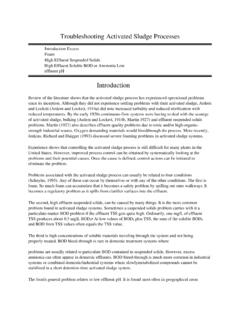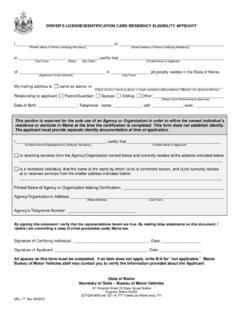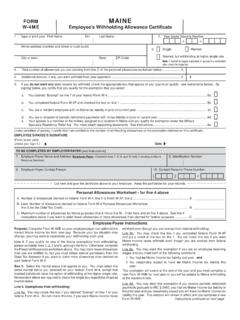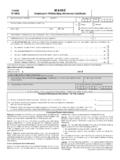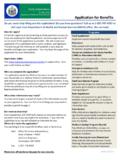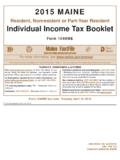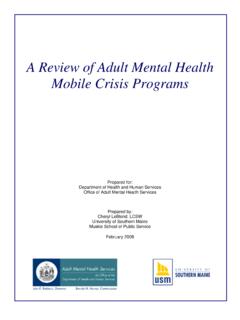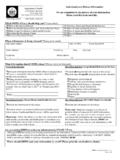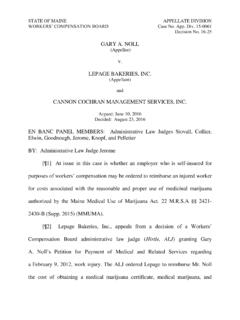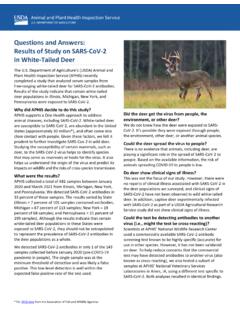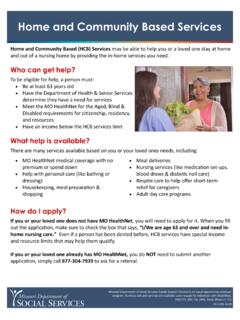Transcription of Standard Operating Procedure (SOP)
1 1 Standard Operating Procedure (SOP) Issued: 8/26/2020 Revised: 12/30/2021 (See Change Log/Appendix F) SUBJECT: Investigation of COVID-19 Cases in Pre-K-12 Schools Maine Center for Disease Control and Prevention Division of Disease Surveillance I. PURPOSE This SOP provides a framework for responding to COVID-19 cases among students, teachers, or staff within a school. The guidance in this SOP is not exhaustive, nor does it replace a school s strategic plan for COVID-19, or direct engagement with the Maine Department of Education (Maine DOE) or Maine Center for Disease Control and Prevention (Maine CDC). The primary goal of this document is to enable students and staff to remain in the school classroom through vaccination, pooled testing, isolation/quarantine, and masking. II. ISOLATION AND QUARANTINE Case Definitions Maine CDC is following case definitions for COVID-19 as established by the Council of State and Territorial Epidemiologists.
2 The current case definitions can be found here. These case definitions are subject to change. School Responsibilities A designated school staff member affiliated with the school where a case of COVID-19 is identified will be the primary point of contact and serve as an essential part of any epidemiological investigation. The designee should contact other applicable designated school administrators, school health advisors/school physicians, as needed. The designated school staff member shall serve as the primary point of contact for families of confirmed cases. The designee should: Communicate with the family of a confirmed case and share guidance on isolation and quarantine for the confirmed case and for family members living in the same household; Provide an anticipated release from isolation date, specifically for those individuals who will not be investigated; Make social service referrals with the family s permission to Recommend that the parent/guardian monitor other family members for symptoms of COVID-19; Advise families to alert their health care provider of the positive COVID-19 test, especially if symptoms worsen; and Advise close contacts to seek a COVID-19 test.
3 2 Laboratory Testing Maine CDC recommends testing close contacts of COVID-19 cases. Asymptomatic close contacts should test on day 5 following exposure. Symptomatic close contacts should test as soon as possible. Because of the potential for asymptomatic and pre-symptomatic transmission, it is important that close contacts of COVID-19 cases be identified and tested in the appropriate time frame. Individuals identified as close contacts should follow the CDC s guidance on quarantine. Testing of close contacts also helps identify additional cases and helps identify further close contacts who should quarantine. PCR confirmation of a positive antigen test is not required if the antigen test is conducted on an individual with a known exposure to a positive case or linked positive PCR pooled test. In general, individuals who test positive should not be retested for 90 days following the date of the positive test result.
4 However, an individual who develops new onset of symptoms consistent with COVID-19 infection during the 90-day period following the initial positive test collection date should be retested and should isolate until 24 hours after symptoms have resolved although there will not be contact tracing. An individual who tests positive again 90 days after the last positive test must complete isolation following the new, positive result. Pooled testing participants do not need additional testing beyond the pooled testing if identified as close contacts. At-Home Test Results With increasing availability of at-home COVID-19 tests, schools may choose to accept the results from such tests. Please note that Maine CDC does not investigate or accept reports of positive results from at-home tests or count such positive results as cases. Maine CDC recommends that schools that choose to accept home-based test results do so when the school is able to verify the collection date and patient.
5 Having this information will help determine the start and end dates of isolation and quarantine, if indicated. School-Based Pooled Testing The Maine CDC and Maine Department of Education (DOE) have implemented a pooled PCR testing program, available to public and private schools (private Pre-K-only programs are not eligible to apply). Pooled testing involves mixing several test samples together in a batch or pool and then testing the pooled sample with a PCR test for detection of SARS-CoV-2. The optimum size of each pool is 25 students. Students who participate in this pooled testing program can avoid quarantine if exposed to COVID-19, regardless of vaccination status. In December 2021, the CDC issued guidance on a Test to Stay strategy for students exposed to COVID-19. Test to Stay is a practice comprising contact tracing and serial testing to allow school-associated close contacts who are not fully vaccinated to continue in-person learning and avoid quarantine.
6 Maine CDC recognizes that schools may opt for Test to Stay as another approach to avoiding quarantine. Isolation, Contact Tracing, and Quarantine All students, teachers, or staff who test positive for COVID-19, regardless of vaccination status, 3 shall isolate until they meet the CDC criteria for release from isolation. After isolating the positive case, the school-designated contact tracer should identify and notify all close contacts (see Appendix A). Maine DOE will work with school officials to provide technical assistance in the identification of close contacts within schools. In a school setting where there is no assigned seating the whole classroom will be counted as close contacts. Where a school strictly adheres to assigned seating, close contacts will be identified using the definition above. Exposures that occur in outdoor settings or on a school bus do not constitute a close contact and, thus, do not require quarantine, regardless of vaccination status.
7 This applies even where there is physical contact in outdoor settings ( , during sporting events). Designated school staff, along with other school officials, should make initial contact with close contacts to ensure they begin their quarantine period in a timely manner. If close contacts need to quarantine from school, and are identified while school is in session, they may complete the day and must be masked. If private transport is unavailable, taking the bus home is acceptable. Those who are enrolled in the pooled testing program should be informed of their need to quarantine outside of school activities and the need to monitor for symptoms. Quarantine Exemptions Close contacts must quarantine for 5 days from last COVID-19 exposure from school and school activities and then wear a mask for an additional 5 days unless at least one of the following conditions applies: 1.
8 The close contact (staff or student) is boosted; or 2. The close contact is a fully vaccinated 16-17 year old student who, according to the CDC, may receive a booster but has not yet done so; or 3. The close contact (staff or student) is not eligible for a booster but is fully vaccinated; or 4. The close contact (staff or student) completed their second mRNA dose within 6 months (or completed their J&J vaccine within two months); or 5. The close contact (staff or student) participates in school pooled testing; or 6. The school is enforcing a mandatory masking policy. Staff and students who do not fall within exceptions 1-6 above must quarantine if they are a close contact, regardless of the location of exposure. If the student or staff only fall within exceptions 5-6, they must quarantine in the community, per Maine CDC quarantine guidelines. 4 Table 1: Summary of Quarantine Exceptions After the school designee has identified close contacts, the school s contact tracer can use the table below or description above to follow up.
9 Every close contact should receive a letter alerting them to the exposure and providing guidance (Appendix B & Appendix C). 5 III. OUTBREAK RESPONSE Beginning in January 2022, the Maine CDC will open an epidemiological investigation in a school when at least 15% of students and staff are absent due to illness. This approach is consistent with Maine CDC s approach to other communicable diseases, including other respiratory illnesses. Schools will use the absenteeism reporting module in NEO, which is the Standard process for reporting health-related absenteeism. Schools who do not have access to NEO should report the 15% absenteeism to Maine CDC by email to (do not send any personal identifying information), by fax at 207-287-6865, or by phone to 1-800-821-5821. When a school reports 15% absenteeism, Maine CDC will follow up with the school to obtain additional information and determine if the absenteeism report meets outbreak status.
10 Among other pieces of information, Maine CDC will inquire about: Number of COVID-19 positive students and staff; Number by test type (PCR or antigen); Number of students of staff who are in quarantine and not in school; and Number of students and staff working/attending remotely. After the initial 15% absenteeism report, a school must then report absenteeism daily. Outbreaks will be closed after 14 consecutive days with reports of <15% absenteeism. If a school on day 15 has 15% absenteeism, then a new outbreak would be opened. The school should notify all associated individuals of the outbreak (see Section V below). School officials should make such notifications in writing, using a template provided by Maine CDC (see Appendix A). School outbreak status does not necessarily warrant school closure and can be evaluated on a case-by-case basis. Maine CDC may, however, recommend suspending some or even all in-person extra-curricular activities for the duration of the outbreak.
